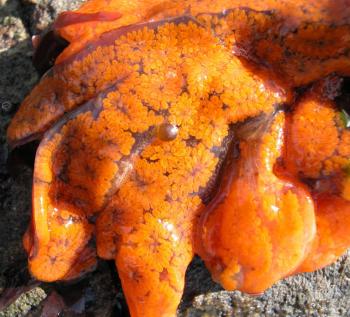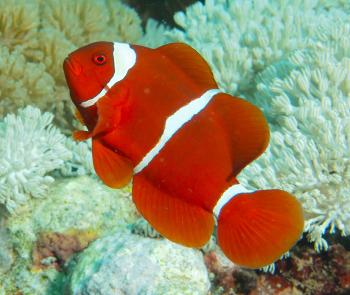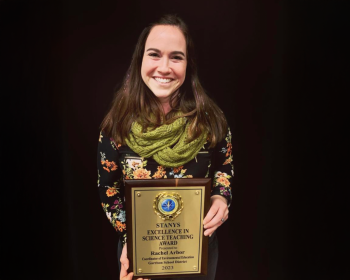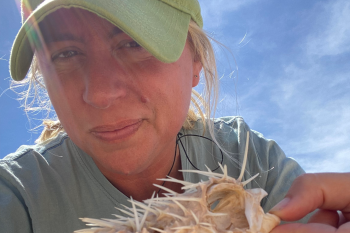
Standards
Cell Biology
1. All living organisms are composed of cells, from just one to many trillions, whose details usually are visible only through a microscope.
Cell Biology
1. All living organisms are composed of cells, from just one to many trillions, whose details usually are visible only through a microscope. As a basis for understanding this concept:
f. Students know that as multicellular organisms develop, their cells differentiate.
Genetics
2. A typical cell of any organism contains genetic instructions that specify its traits. Those traits may be modified by environmental influences.
Genetics
2. A typical cell of any organism contains genetic instructions that specify its traits. Those traits may be modified by environmental influences. As a basis for understanding this concept:
a. Students know the differences between the life cycles and reproduction methods of sexual and asexual organisms.
Genetics
2. A typical cell of any organism contains genetic instructions that specify its traits. Those traits may be modified by environmental influences. As a basis for understanding this concept:
d. Students know plant and animal cells contain many thousands of different genes and typically have two copies of every gene. The two copies (or alleles) of the gene may or may not be identical, and one may be dominant in determining the phenotype while the other is recessive.
Genetics
2. A typical cell of any organism contains genetic instructions that specify its traits. Those traits may be modified by environmental influences. As a basis for understanding this concept:
e. Students know DNA (deoxyribonucleic acid) is the genetic material of living organisms and is located in the chromosomes of each cell.
Evolution
3. Biological evolution accounts for the diversity of species developed through gradual processes over many generations.
Evolution
3. Biological evolution accounts for the diversity of species developed through gradual processes over many generations. As a basis for understanding this concept:
a. Students know both genetic variation and environmental factors are causes of evolution and diversity of organisms.
Evolution
3. Biological evolution accounts for the diversity of species developed through gradual processes over many generations. As a basis for understanding this concept:
c. Students know how independent lines of evidence from geology, fossils, and comparative anatomy provide the bases for the theory of evolution.
Evolution
3. Biological evolution accounts for the diversity of species developed through gradual processes over many generations. As a basis for understanding this concept:
e. Students know that extinction of a species occurs when the environment changes and the adaptive characteristics of a species are insufficient for its survival.
Earth and Life History (Earth Sciences)
4. Evidence from rocks allows us to understand the evolution of life on Earth.
Earth and Life History (Earth Sciences)
4. Evidence from rocks allows us to understand the evolution of life on Earth. As a basis for understanding this concept:
b. Students know the history of life on Earth has been disrupted by major catastrophic events, such as major volcanic eruptions or the impacts of asteroids.
Earth and Life History (Earth Sciences)
4. Evidence from rocks allows us to understand the evolution of life on Earth. As a basis for understanding this concept:
e. Students know fossils provide evidence of how life and environmental conditions have changed.
Earth and Life History (Earth Sciences)
4. Evidence from rocks allows us to understand the evolution of life on Earth. As a basis for understanding this concept:
g. Students know how to explain significant developments and extinctions of plant and animal life on the geologic time scale.
The anatomy and physiology of plants and animals illustrate the complementary nature of structure and function.
Structure and Function in Living Systems
5. The anatomy and physiology of plants and animals illustrate the complementary nature of structure and function. As a basis for understanding this concept:
a. Students know plants and animals have levels of organization for structure and function, including cells, tissues, organs, organ systems, and the whole organism.
Structure and Function in Living Systems
5. The anatomy and physiology of plants and animals illustrate the complementary nature of structure and function. As a basis for understanding this concept:
c. Students know how bones and muscles work together to provide a structural framework for movement.
Structure and Function in Living Systems
5. The anatomy and physiology of plants and animals illustrate the complementary nature of structure and function. As a basis for understanding this concept:
g. Students know how to relate the structures of the eye and ear to their functions.
Investigation and Experimentation
7. Scientific progress is made by asking meaningful questions and conducting careful investigations. As a basis for understanding this concept and addressing the content in the other three strands, students should develop their own questions and perform investigations.
M.C.1: Structure and function in living systems
M.C.1.a Living systems at all levels of organization demonstrate the complementary nature of structure and function. Important levels of organization for structure and function include cells, organs, tissues, organ systems, whole organisms, and ecosystems.
M.C.1 Structure and function in living systems
b. All organisms are composed of cells–the fundamental unit of life. Most organisms are single cells; other organisms, including humans, are multicellular.
d. Specialized cells perform specialized functions in multicellular organisms. Groups of specialized cells cooperate to form a tissue, such as a muscle. Different tissues are in turn grouped together to form larger functional units, called organs. Each type of cell, tissue, and organ has a distinct structure and set of functions that serve the organism as a whole.
M.C.1 Structure and function in living systems
d. Specialized cells perform specialized functions in multicellular organisms. Groups of specialized cells cooperate to form a tissue, such as a muscle. Different tissues are in turn grouped together to form larger functional units, called organs. Each type of cell, tissue, and organ has a distinct structure and set of functions that serve the organism as a whole.
M.C. 2 Reproduction and heredity.
M.C. 2.a The characteristics of an organism can be described in terms of a combination of traits. Some traits are inherited and others result from interactions with the environment.
M.C.2 Reproduction and heredity
c. Every organism requires a set of instructions for specifying its traits. Heredity is the passage of these instructions from one generation to another.
M.C. 2 Reproduction and heredity.
d. Hereditary information is contained in genes, located in the chromosomes of each cell. Each gene carries a single unit of information. An inherited trait of an individual can be determined by one or by many genes, and a single gene can influence more than one trait. A human cell contains many thousands of different genes.
M.C.2 Reproduction and heredity
An animal can be described in terms of a combination of inherited traits.
M.C.3 Regulation and Behavior
d. An organism's behavior evolves through adaptation to its environment. How a species moves, obtains food, reproduces, and responds to danger are based in the species' evolutionary history.
M.C.5 Diversity and adaptation of organisms
a. Millions of species of animals, plants, and microorganisms are alive today. Although different species might look dissimilar, the unity among organisms becomes apparent from an analysis of internal structures, the similarity of their chemical processes, and the evidence of common ancestry.
M.C.5 Diversity and adaptation of organisms
c. Extinction of a species occurs when the environment changes and the adaptive characteristics of a species are insufficient to allow its survival. Fossils indicate that many organisms that lived long ago are extinct. Extinction of species is common; most of the species that have lived on the earth no longer exist.
M.D.2 Earth’s History
b. Fossils provide important evidence of how life and environmental conditions have changed.
M.G.1 Science as a human endeavor
a. Women and men of various social and ethnic backgrounds–and with diverse interests, talents, qualities, and motivations–engage in the activities of science, engineering, and related fields such as the health professions. Some scientists work in teams, and some work alone, but all communicate
b. Science requires different abilities, depending on such factors as the field of study and type of inquiry. Science is very much a human endeavor, and the work of science relies on basic human qualities, such as reasoning, insight, energy, skill, and creativity–as well as on scientific habits of mind, such as intellectual honesty, tolerance of ambiguity, skepticism, and openness to new ideas.
M.G.1 Science as a human endeavor
a. Women and men of various social and ethnic backgrounds–and with diverse interests, talents, qualities, and motivations–engage in the activities of science, engineering, and related fields such as the health professions. Some scientists work in teams, and some work alone, but all communicate.
M.G.1 Science as a human endeavor
b. Science requires different abilities, depending on such factors as the field of study and type of inquiry. Science is very much a human endeavor, and the work of science relies on basic human qualities, such as reasoning, insight, energy, skill, and creativity–as well as on scientific habits of mind, such as intellectual honesty, tolerance of ambiguity, skepticism, and openness to new ideas.
M.U.2 Evidence, models, and explanation
a. Evidence–Evidence consists of observations and data on which to base scientific explanations. The goal is to help students use evidence to understand interactions and predict changes.
c. Explanations–Explanations provide interpretation, meaning, or sense to objects, organisms, or events. Explanations incorporate existing scientific knowledge and new evidence from observations, experiments, or models into internally consistent, logical statements, such as hypotheses, laws, principles, and theories. The goal is to help students create explanations which incorporate a scientific knowledge base, logic, and higher levels of analysis.
M.U.4 Evolution and Equilibrium
a. Evolution–Evolution is a series of changes, some gradual and some sporadic, that account for the present form and function of objects, organisms, and natural and designed systems. The goal is for students to recognize that objects & systems change over time.
Patterns can be used to identify cause and effect relationships.
Complex and microscopic structures and systems can be visualized, modeled, and used to describe how their function depends on the shapes, composition, and relationships among its parts, therefore complex natural structures/systems can be analyzed to determine how they function.
In multicellular organisms, the body is a system of interacting tissues and organs, specialized for particular body functions.
Growth and Development of Organisms
Animals engage in characteristic behaviors that increase the odds of reproduction.
Information Processing
Sense receptors transmit signals along nerve cells to the brain, resulting in behaviors.
Genes control the traits of the organism. Changes (mutations) to genes can affect the structures and functions of the organism and thereby change traits.
The fossil record documents the existence, diversity, extinction, and change of many life forms throughout the history of life on Earth.
Anatomical similarities and differences between various organisms living today and between them and organisms in the fossil record, enable the reconstruction of evolutionary history and the inference of lines of evolutionary descent.
Adaptation by natural selection acting over generations is one important process by which species change over time in response to changes in environmental conditions.
Scientists and engineers are guided by habits of mind such as intellectual honesty, tolerance of ambiguity, skepticism, and openness to new ideas.
Science assumes that objects and events in natural systems occur in consistent patterns that are understandable through measurement and observation.
Science knowledge is based upon logical and conceptual connections between evidence and explanations.















